From Wein and Wrighton to Moore — and BEYOND…

Our pal Rich Handley’s got a new book out — Born on the Bayou: A Pre-Flashpoint Chronology of Swamp Thing and Hellblazer, with a cover by Steve Bissette.
The book is perfect holiday gift for the swamp maven in your life (or worth putting on your own list). The 558-pager is available at online retailers, including the publisher BearManor Media, for a variety of prices, depending on the format.
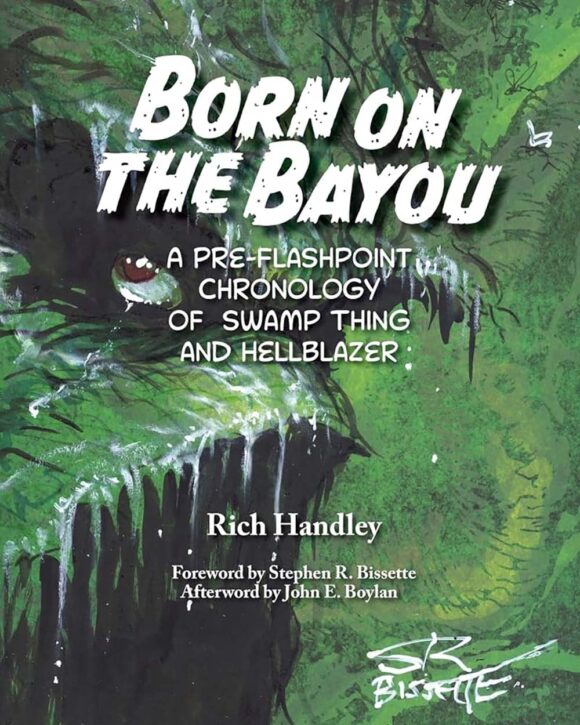
Anyway, it turns out you can break down Swampy’s history into 13 distinct eras before the 2011 event Flashpoint, so Rich is here to wade you through each one them.
Right on.
—
By RICH HANDLEY
In 1971, Len Wein and Bernie Wrightson created a sympathetic moss-monster for DC Comics who was more than his horrifying exterior conveyed. Bog-dwellers such as Airboy Comics’ Heap had long stalked the swamps, and Marvel Comics unveiled its own take on the concept, Man-Thing, at the same time as Swamp Thing’s debut—created by Wein’s roommate Gerry Conway, no less. Of course, both titles had their roots, so to speak, in Theodore Sturgeon’s It! (1940), published in the pulp magazine Unknown, so the idea was not entirely new.
The initial Wein-Wrightson eight-pager, published in House of Secrets #92, was titled Swamp Thing. That story, set at the start of the 20th century, was simple enough: scientist Alex Olsen, murdered by friend Damian Ridge, was reborn as a swamp monster, a muck-encrusted mockery of a man, and was shunned as hideous by beloved wife Linda. This is not the only time such a plot device has been employed (see Sam Raimi’s Darkman, for example), but Wrightson’s vibrant, haunting illustrations, combined with Wein’s creepy text and passion for gothic monsters, created something special.
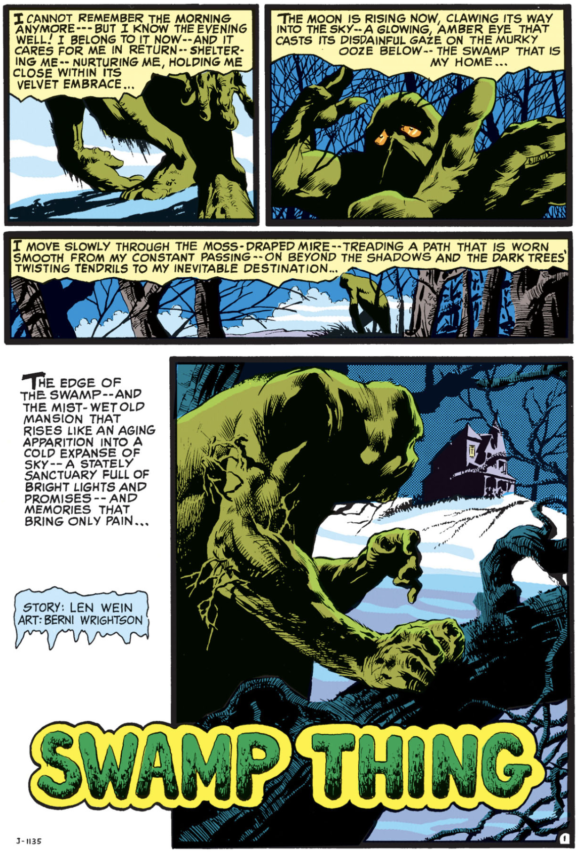
House of Secrets #92
That brief tale inspired a millennia-spanning mythology that continued to be told for decades, starring Olsen’s similarly named successor Alec Holland—until 2011, when DC wiped the slate clean. With its Flashpoint crossover event and subsequent company-wide The New 52 reboot, DC unveiled dozens of replacement titles that erased all established history and started over anew. The post-Flashpoint era flourished despite a rocky start, and writers have revisited the original continuity from time to time, but what had existed before in the pages of Swamp Thing was irreplaceable.
Frustration at the new cards DC had dealt bred nostalgia for the winning hand of the past, and some readers opted not to go all in, deeming the dealer’s choice a cold deck. Many preferred the game before DC had played 52-pickup with its lineup, and so the new full house left them more flustered than flush. To celebrate the prior continuity from before that reboot, this article’s writer spent years creating Born on the Bayou: A Pre-Flashpoint Chronology of Swamp Thing and Hellblazer, published in 2023 by BearManor Media Books. Rather than getting bogged down in the muck and mire of The New 52, however, let’s examine the 13 PRE-FLASHPOINT SWAMP THING ERAS that will do right bayou.
—

1. Swamp Thing Series One: Len Wein. Wein turned his House of Secrets one-off into a monthly gothic horror title that seemed plucked right out of the Universal Monsters franchise. The saga, now set in the 1970s, starred Alec Holland, whose name, origin, plight, and even wife remarkably resembled those of his post-Victorian predecessor. During the comic’s freshman year, Swamp Thing roamed the land in a perpetual state of depression, attacked by all manner of antagonists both human and supernatural. Wrightson left after 10 issues, with Wein departing three installments later, and during this span Swamp Thing met Batman in Bob Haney’s The Brave and the Bold #122. Though quaint by today’s standards, the Wein-Wrightson run was groundbreaking and beautiful.
—
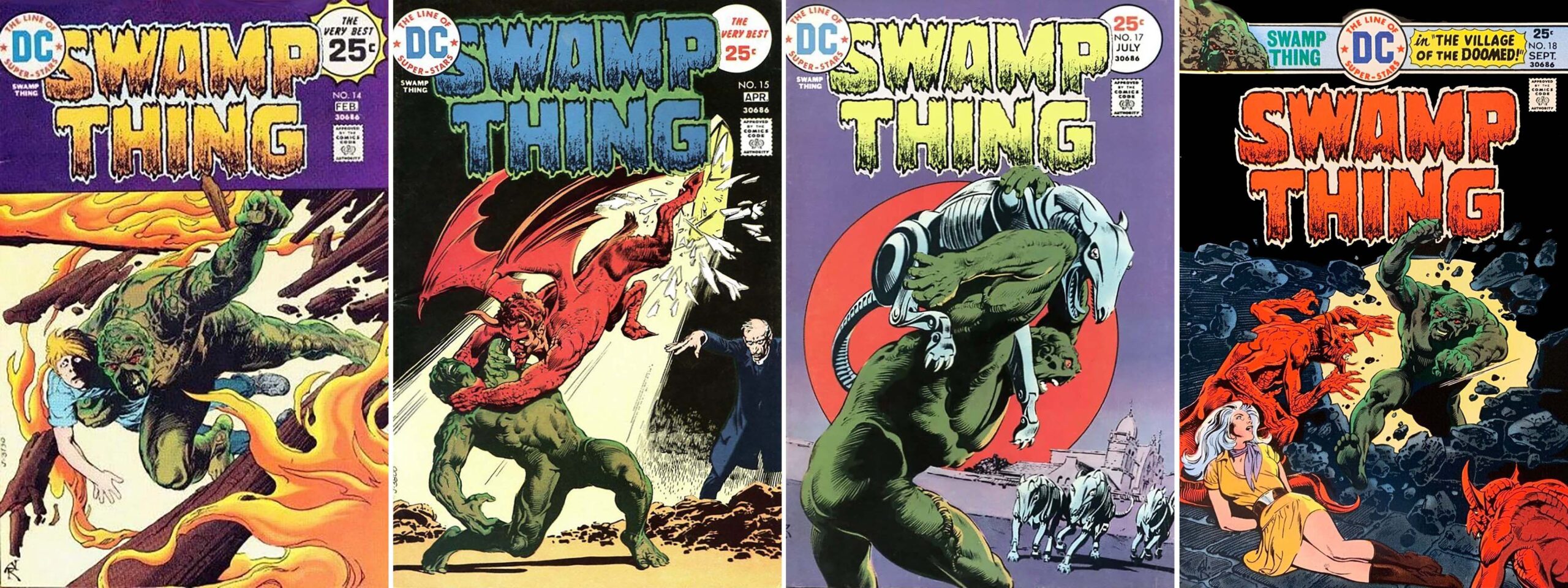
2. Swamp Thing Series One: David Michelinie. Wrightson and Wein were succeeded by the talented team of artist Nestor Redondo and writer David Michelinie. Redondo stayed aboard as artist until the end, with Ernie Chan and Fred Carrillo drawing the final issue, and Michelinie’s approach to gothic horror synched well with what Wein had begun. The macabre Wein and Michelinie eras, collected in various editions, are vital components of Swamp Thing history, as they introduced and developed several key players. Chief among them: depraved Transylvanian wizard Anton Arcane, Alec Holland’s arch-nemesis; Lieutenant Matt Cable, the Hollands’ pal and protector, later known to Sandman and The Dreaming fans as Matthew the raven; and Arcane’s white-haired, slightly psychic niece Abigail, the future wife of both Matt and Alec.
—

3. Swamp Thing Series One: Gerry Conway and David Anthony Kraft. Gerry Conway and David Anthony Kraft finished out the first Swamp Thing iteration by making it more a superhero title than horror, and Conway also penned solo tales about Abby’s father Gregori Arcane, the Patchwork Man, for House of Secrets #140–141, though the #141 chapter only appeared in Sweden’s Gigant #3 (1983). Those two stories, illustrated by Redondo, represent a failed Swamp Thing spinoff intended to run in House of Secrets. Alec Holland’s adventures were cut short in 1976 when the series was canceled after only 24 issues, and while a 25th chapter was advertised as featuring a team-up with Hawkman, that story failed to materialize. Thankfully, the lost Patchwork Man and Hawkman stories have both been included in recent omnibus editions.
—

4. The In-Between Era: Challengers of the Unknown. Following Swamp Thing’s cancelation, the mossy man-brute co-starred in Conway’s Challengers of the Unknown #81–87, as well as in Steve Englehart’s DC Comics Presents #8 and Martin Pasko’s The Brave and the Bold #176, while Matt Cable guest-starred with the Doom Patrol in Paul Kupperberg’s Showcase #94–96. Alec wandered the country wallowing in freakish misery (Princess Bride reference intended), desperate to regain his humanity—which he briefly did, thanks to his brother Edward’s scientific genius. Challengers then reversed that success, transforming the hero into a muck-man once more, which was unlucky for hapless Holland but lucky for fans, for in resuming the Swamp Thing mantle, Alec was thus available for a series revival.
—
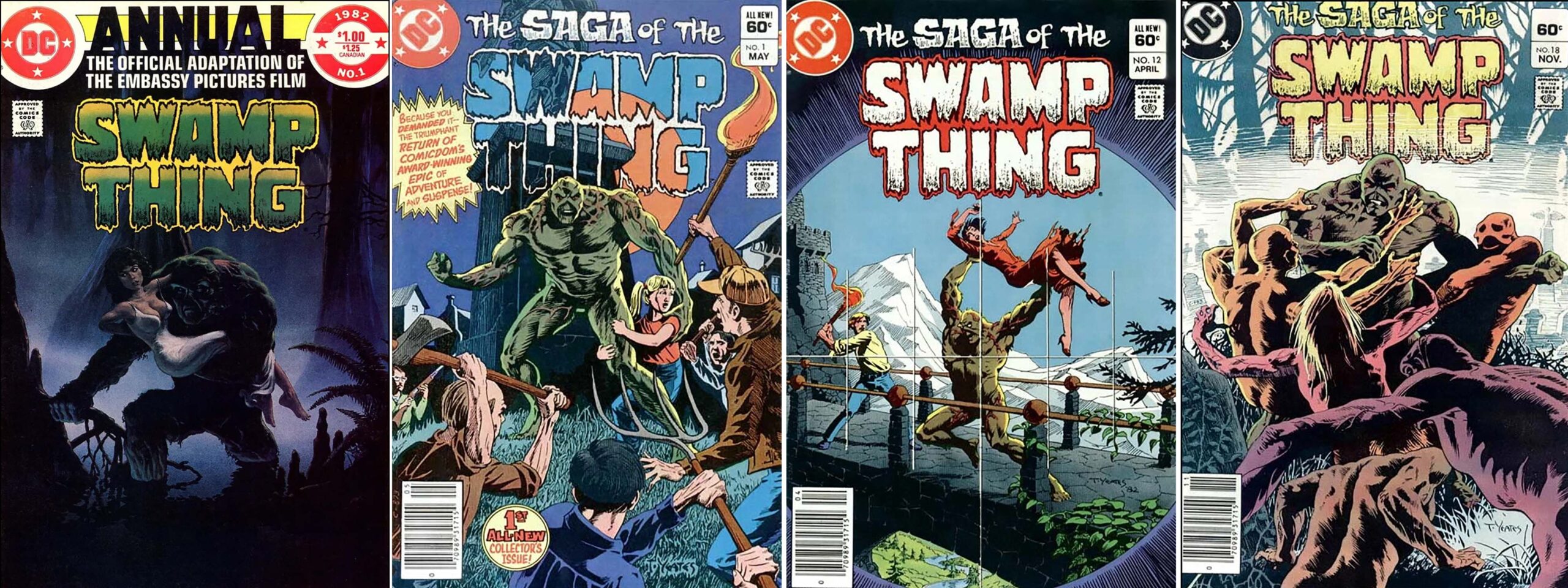
5. Swamp Thing Series Two: Martin Pasko. Following the release of 1982’s Swamp Thing film, DC unveiled The Saga of the Swamp Thing with an adaptation of that movie. A subsequent monthly comic spanned 171 issues and seven annuals, with Martin Pasko and Tom Yeates rejuvenating the much-loved title after a six-year hiatus. A lengthy plot involving the Antichrist and Nazis met with mixed reactions, but essential players came out of that compelling run, including journalist Lizabeth Tremayne, a Swamp Thing staple; Dennis Barclay, who underwent a creepy transformation from ally to enemy; and General Sunderland, whose business empire plagued Alec’s family for decades. Most significantly, Pasko brought Matt Cable, as well as Abby and Anton Arcane, back into the fold.
—
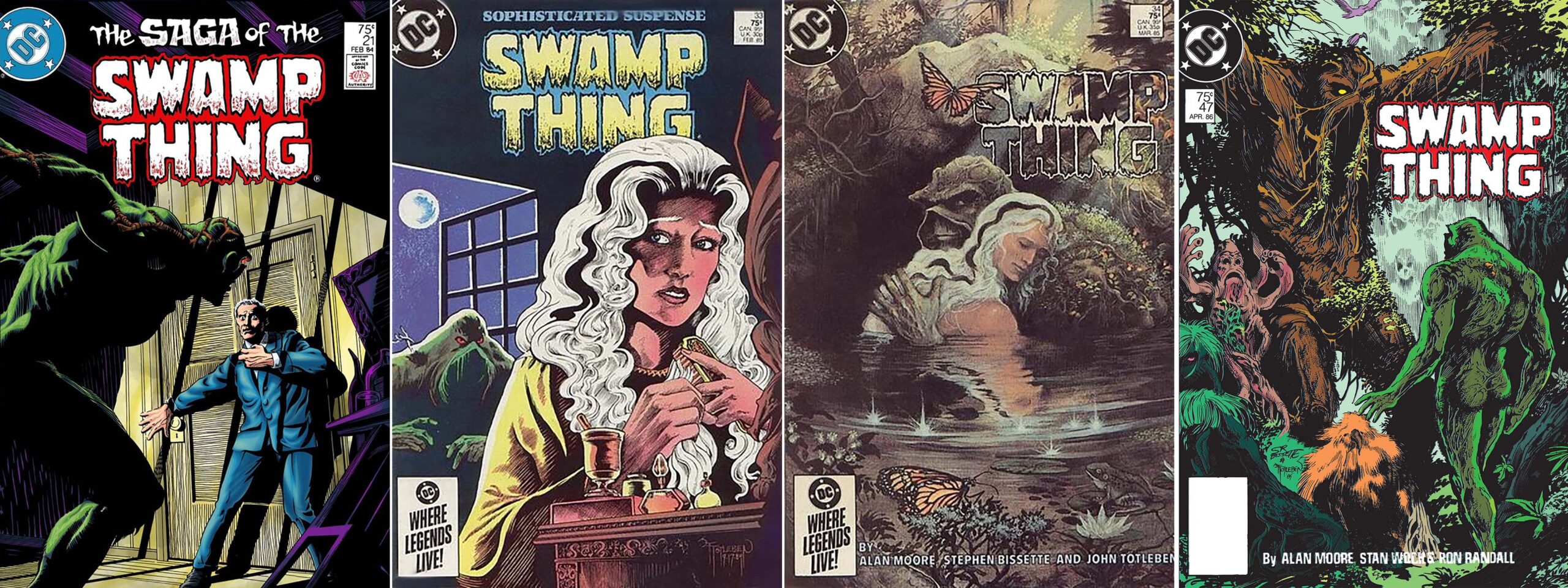
6. Swamp Thing Series Two: Alan Moore. In a single chapter, writer Alan Moore un-did all that had come before. Readers had followed Alec’s journey for a dozen years, yet Moore—with artists Stephen R. Bissette, John Totleben, Rick Veitch and Alfredo Alcala—revealed that Alec could never regain his humanity (Edward’s genius notwithstanding), because he’d never had it to begin with. Alec had been dead since day one, and the creature with his memories was a plant that thought itself a man. That revolutionary change carried Swamp Thing to the stars, introduced occultist John Constantine, and culminated in the game-changing reveal of the Parliament of Trees, providing Swamp Thing with a vast elemental lineage that included the original House of Secrets story. Moore wrote 45 tales in total, including a Superman crossover in DC Comics Presents #85, and his work remains the gold standard.
—
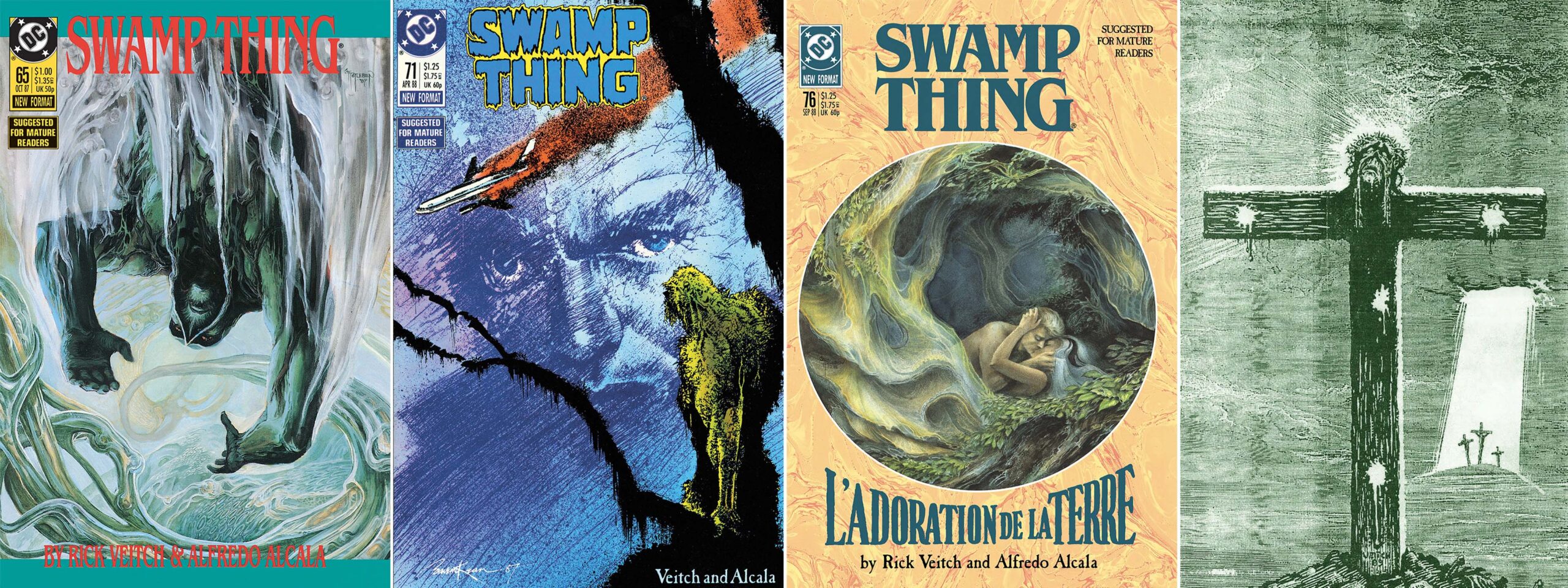
7. Swamp Thing Series Two: Rick Veitch. No stranger to Swamp Thing, Veitch maintained Moore’s poetic narrative, evolved Liz and Chester into more nuanced characters, and tossed Swamp Thing back to the dawn of his own creation, reviving characters from DC’s early years such as Jonah Hex, Merlin, and Tomahawk. During this span, Swamp Thing appeared in Cary Bates’ Captain Atom #16–17, Jamie Delano’s Hellblazer spinoff, and Neil Gaiman’s Black Orchid miniseries. Veitch’s arc was cut short four issues before its completion, when DC nixed #88, in which Swamp Thing would have met Jesus. Worried about a public backlash similar to those stemming from Salman Rushdie’s novel Satanic Verses and the film The Last Temptation of Christ, DC refused to run the story. Veitch thus quit, and DC frantically sought a replacement writer. Enter Doug Wheeler.
—
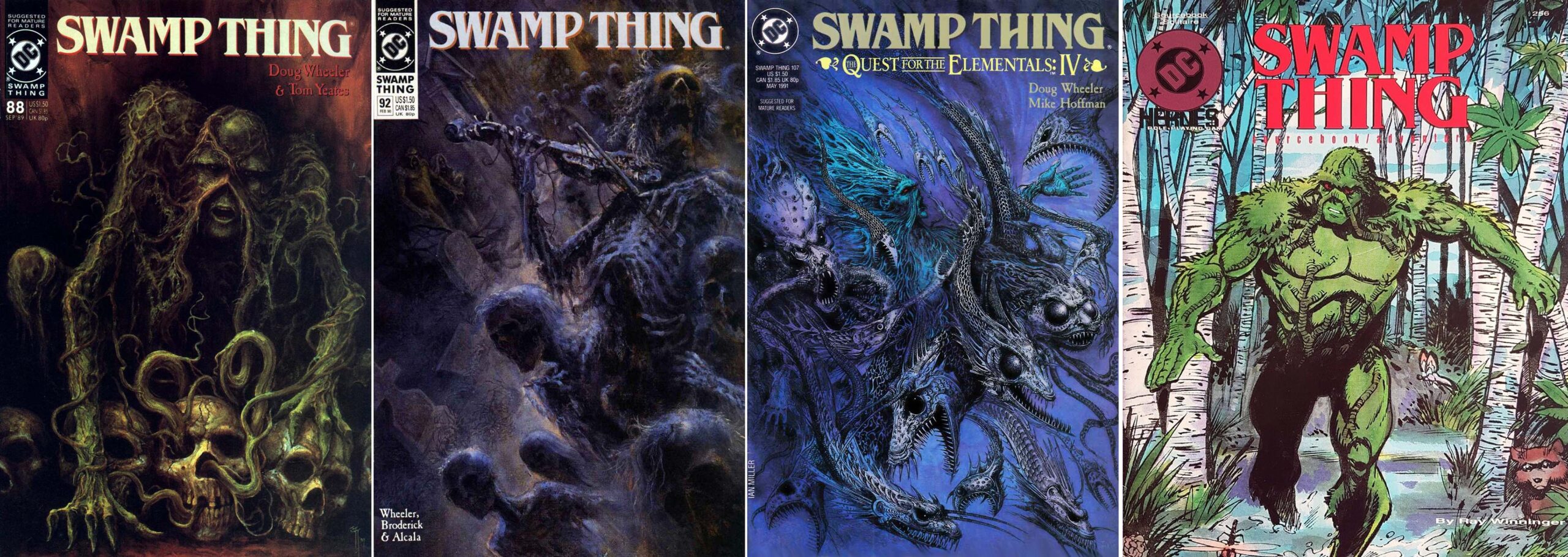
8. Swamp Thing Series Two: Doug Wheeler. Wheeler conceived a workable ending to Veitch’s aborted time odyssey and brought Arcane back from the dead. Though his “Quest for the Elementals” was among the series’ weakest arcs, his early stories were eerie and often amusing. The now-reclusive writer introduced Swamp Thing’s daughter Tefé and revealed several new elementals. Despite inferior artwork and a lackluster plot involving an evil dinosaur mushroom-god called Matango, this run is better than how people tend to remember it, and it sported some of the best covers. Around the same time, DC produced a Swamp Thing sourcebook for its DC Heroes Roleplaying Game, featuring a short story called “Racing with the Rats” that was decidedly mediocre. Readers were ready for a different direction.
—

9. Swamp Thing Series Two: Nancy A. Collins. Horror novelist Nancy Collins offered just that, with help from artists Tom Mandrake, Scot Eaton and Kim DeMulder. The common motif was family, as Collins spotlighted the Alec-Abby mixed marriage, explored the challenges of parenting an infant elemental, revived incestuous Uncle Anton, introduced Sunderland’s wife and daughter, and explored Constantine’s ancestry, while also adding Lady Jane, a wood-witch assigned by the Parliament to serve as Tefé’s nanny. Jane remained a staple until Collins’ departure, when Jane’s true mission—to seduce the bog-god and disrupt his domestic bliss—was unveiled in a heartbreaking cliffhanger. Collins also wrote a Swamp Thing tale for Vertigo Jam: Louder Than Noise, and her run was followed by Dave Louapre’s Arcane-centric miniseries American Freak: A Tale of the Un-Men.
—
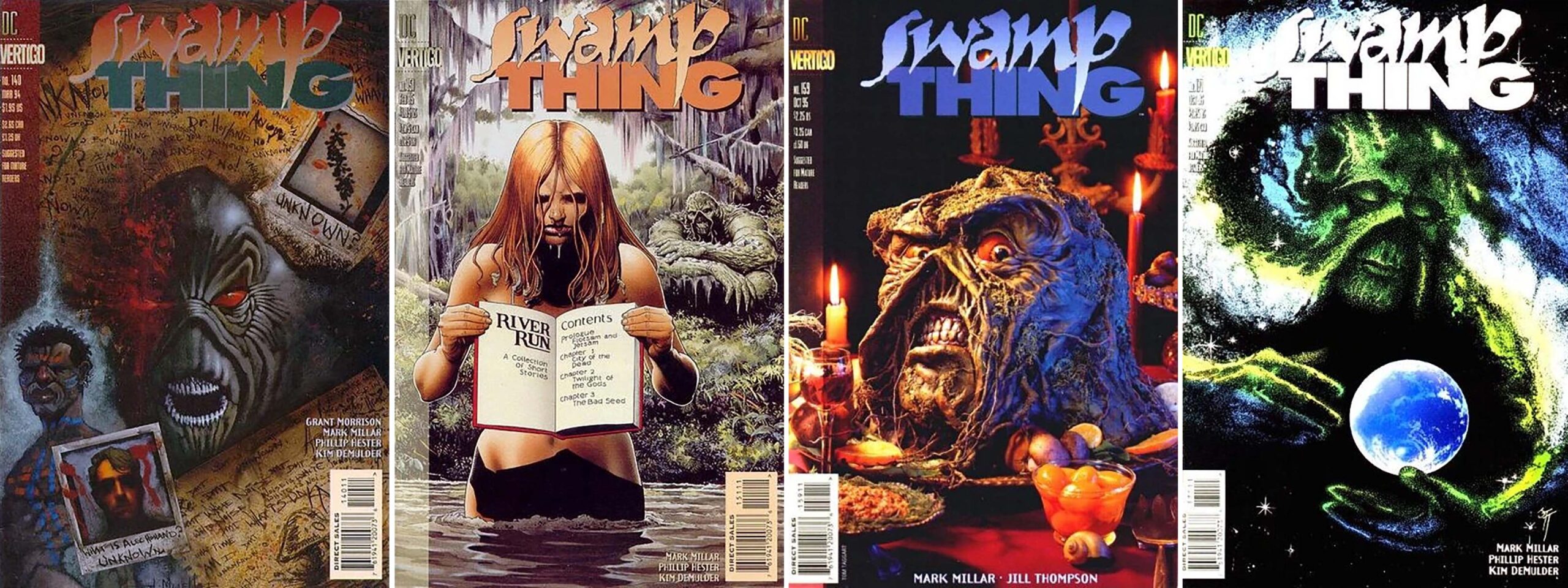
10. Swamp Thing Series Two: Grant Morrison and Mark Millar. Closing out the second run, writers Grant Morison and Mark Millar and artists Phillip Hester and Kim DeMulder blew the mythos wide open. They transformed the Parliament from a source of spiritual guidance to an untrustworthy adversary, revealed a hierarchy of other Parliaments, and evolved Swamp Thing to deadly godhood. Alec undertook trials of self-discovery, witnessed distorted and depraved depictions of reality, and was rewarded with dominion over each parliament in turn, rendering him increasingly powerful yet disconnected from humanity. Alec’s unpredictable journey was riveting, with a spectrum of unsavory characters dwelling in the dark-gray area of morality. It’s appropriate, then, that his guest appearances in this era (The Demon #51 and Batman #521–522) tended toward darkness as well.
—

11. Swamp Thing Series Three: Brian K. Vaughan and Others. Swamp Thing guest-starred in Aquaman #32–33, The Spectre #62, Starman #48, and Martian Manhunter #11, while Sandman’s The Dreaming featured storylines spotlighting Matt Cable. This period saw the release of Jon J. Muth’s beautifully painted one-shot Swamp Thing: Roots; Tom Peyer’s V2K: Totems; and “Jack-in-the-Green,” in Neil Gaiman’s Midnight Days. A third Swamp Thing volume followed from Brian K. Vaughan and a rotating artist bullpen, starring Tefé. To suppress her teen-angsty powers, Constantine trapped Tefé spirit in the body of a dying teenager, which proved disastrous when her submerged personality reasserted itself. Vaughan outed Tefé as gay, but little else of import happened because the series was prematurely canceled.
—
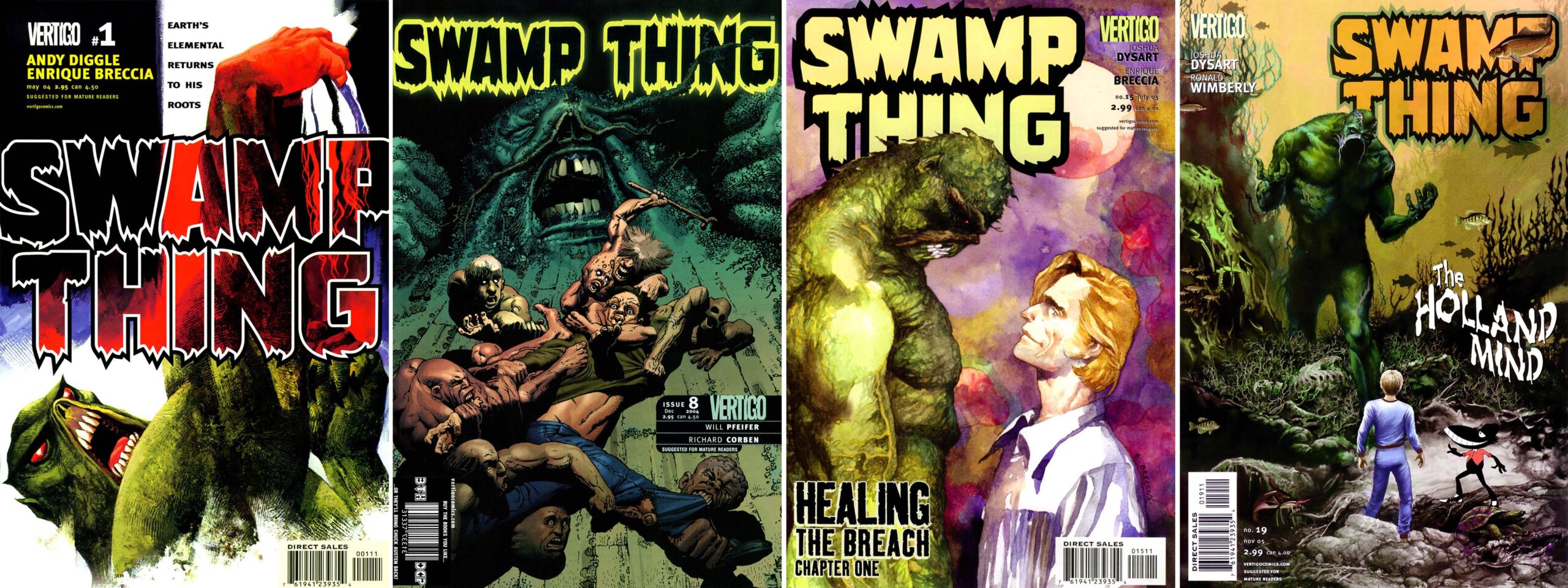
12. Swamp Thing Series Four: Andy Diggle, Will Pfeifer and Joshua Dysart. DC’s fourth Swamp Thing featured short stints by writers Andy Diggle and Will Pfeifer, followed by a lengthy arc from Joshua Dysart, with art by Enrique Breccia, Richard Corben, and others. This series brought the saga full-circle by making Swamp Thing a sullen muck-monster once more. Dysart brought back Sargon the Sorcerer, Anton Arcane, and Jason Woodrue from prior runs, while the larger arc centered around the reforming of Swamp Thing’s shattered consciousness following a crossover with Mike Carey’s Hellblazer. As with Vaughan, the Dysart run was canceled without a proper resolution, and in its wake DC released The Un-Men, an American Freak follow-up crafted by John Whalen and Mike Hawthorne.
—
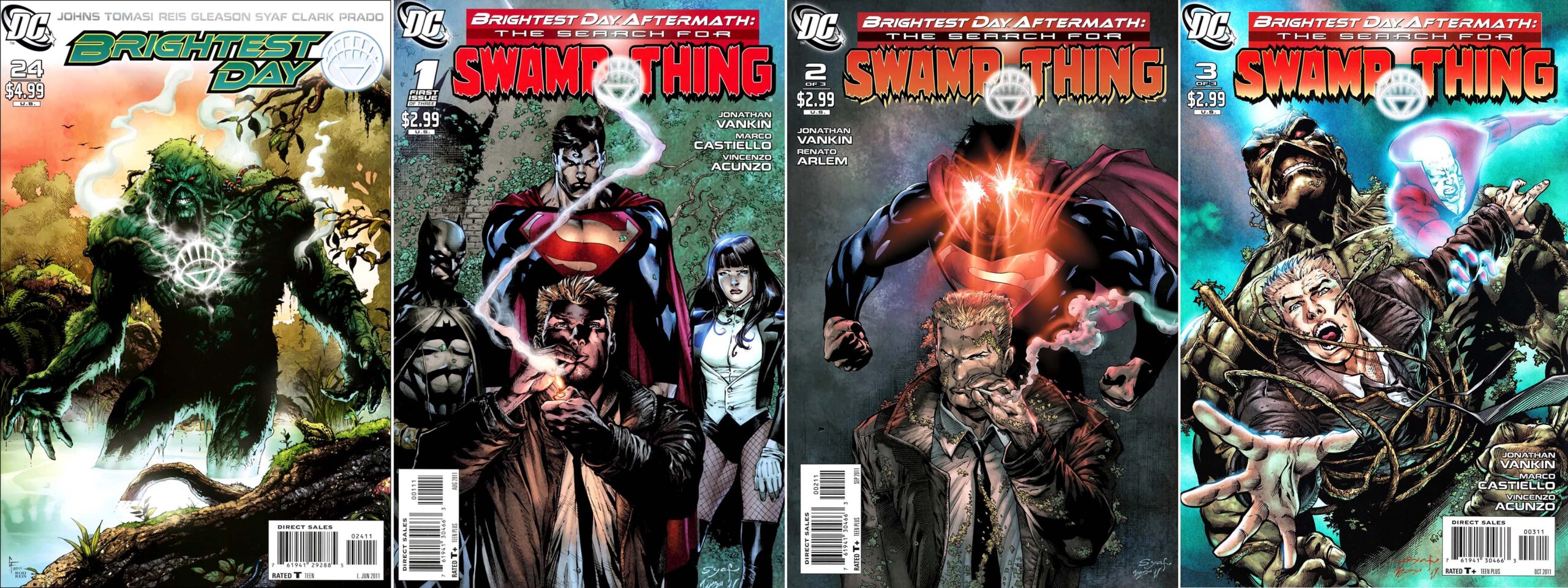
13. Swamp Thing’s End: Geoff Johns and Jonathan Vankin. With Flashpoint, DC set up the revamping of its entire mythos, and Swamp Thing was among the titles relaunched. This was preceded by Geoff Johns’ Brightest Day and Jonathan Vankin’s Brightest Day Aftermath: The Search for the Swamp Thing, in which Alec became corrupted as evil and had to be destroyed—an inferior rehashing of Millar’s final chapters—just in time for The New 52 to change everything.
The result was multiple new titles starring Swamp Thing and John Constantine in the new timeline, which have since inspired onscreen stories, both live-action and animated, some more enjoyable than others. But for many fans of the mossy muck-monster and his macabre mythos, this author among them, it was the days before Flashpoint and The New 52 that were the saga’s greatest. If only DC had never drained the swamp.
—
COMING SOON: The 13 Pre-Flashpoint Eras of HELLBLAZER
—
MORE
— BERNIE WRIGHTSON: A Birthday Salute — From FRANKENSTEIN to SWAMP THING, and MORE. Click here.
— COMIC BOOK DEATH MATCH: Swamp Thing vs. Man-Thing. Click here.
—
RICH HANDLEY (richhandley.com) is an author and editor of numerous Star Trek, Star Wars and Planet of the Apes books and comics, as well as projects involving Watchmen, Back to the Future, Stargate, Dark Shadows, Batman, Red Dwarf and other franchises. His books include Born on the Bayou: A Pre-Flashpoint Chronology of Swamp Thing and Hellblazer (BearManor Media), From Bayou to Abyss: Examining John Constantine, Hellblazer (Sequart) and John Constantine, Hellblazer: 30th Anniversary Celebration (DC Comics). Rich edited Eaglemoss’ Star Trek Graphic Novel Collection and currently writes articles and short fiction for Titan Books’ Star Trek Explorer magazine.
